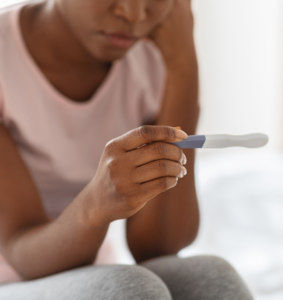
Here at Sex Sense, pregnancy tests are probably one of the most common things we get questions about. Whether you’re hoping for a positive or negative result, needing a pregnancy test can be a stressful moment!
Easy to understand, accurate information can be hard to find, which can make it even more stressful. We are here for you. Here are some of the answers to the things we get asked about the most. If you have questions about your own situation please don’t hesitate to call or email us.
What kind of pregnancy test should I use?
The most common form of pregnancy test is a urine (pee) pregnancy test. These tests look for the pregnancy hormone, human chorionic gonadotrophin (hCG) in your urine. High levels of hCG are made during pregnancy, after the fertilized egg implants (attaches to the uterus). If used correctly, urine pregnancy tests are up to about 99% accurate.
Urine tests are the tests most widely used both at home and in doctor’s offices and clinics. Blood tests aren’t commonly needed to confirm a pregnancy. However, a health care provider may order blood tests for you if they need more information about the pregnancy or in a rare case when an even more sensitive test is needed.
When should I do a pregnancy test?
The short answer is: the best time to test for pregnancy is when you miss a period. Here’s the longer answer:
There are other reasons for a period to be late besides pregnancy. These can include stress, changes in eating or exercise, weight loss, big life changes like moving, and use of birth control or emergency contraception. Also, the amount of time between periods can change for someone throughout their lives.
However, it is important to rule out a pregnancy if you have:
- missed a period
- and have had sex that could have caused a pregnancy (you can learn about what can cause pregnancy here.
Pregnancy tests are usually accurate on the first day of a missed period. If you’re not sure when to expect your next period, you can take the test two weeks after the last sex you are concerned about.
Taking a pregnancy test too early can give a false negative result. In other words, it could say you are not pregnant even if you actually are.
The best time to do a pregnancy test is also early in the day. Ideally with the very first urine (pee) after you wake up. As we drink water throughout the day, it can dilute (water down) the urine. This makes it harder for the test to pick up the hormones it’s looking for.
If the test is negative at the times discussed above, it’s very likely accurate, but if your period still hasn’t come, you may want to do a follow up test one week later just to be sure. This is especially a good idea if the test was not done with the first urine of the day.
Where can I get a pregnancy test?
You can purchase a pregnancy test at a drug store or even sometimes a dollar store to do at home. And keep in mind that the basic ones are just as accurate as the fancy expensive ones!
You can also get one done at a family doctor, walk in clinic, youth clinic, Options for Sexual Health clinic or other sexual health clinic. In BC, having a pregnancy test done at a doctor’s office or clinic will be covered by your Medical Services Plan (Care Card).
clinic, Options for Sexual Health clinic or other sexual health clinic. In BC, having a pregnancy test done at a doctor’s office or clinic will be covered by your Medical Services Plan (Care Card).
Are the home tests as good as the ones used at the doctor’s office/clinic?
Yes, as long as they are not expired and you use it according to the directions, a test you buy at a drug store or dollar store is going to be just as accurate as the ones used by a health care provider. Maybe even more so, because it’s sometimes pretty hard to get into see a doctor or nurse for your first pee of the day!
How do I use a home pregnancy test?
Always follow the instructions that come with the pregnancy test you purchase. There are two basic types of home pregnancy tests:
- The most common types of home pregnancy test use a test strip or dipstick that you hold in the urine stream or dip into a sample of urine. An area on the end of the dipstick or test strip changes in a particular way if the pregnancy hormone hCG is present. Many pregnancy tests will change colour or show a plus sign if the result is positive. However, always check the instructions that come with the test to know how to interpret results.
- A second type uses a urine collection cup with a test device. To use this type of test, you may place several drops of urine into a well in the test device or you put the test device into urine collected in a cup. An area of the device changes colour if the pregnancy hormone hCG is present, meaning you are pregnant.
What if my pregnancy test is positive?
If your pregnancy test results are positive, that means that you are pregnant. False positives (the test saying that you are pregnant when you are not) are very rare. Everyone who is pregnant in Canada has different options. They can:
- end the pregnancy by having an aspiration or medication abortion
- or continue the pregnancy and if it goes full term, parent or make arrangements for someone else to parent
If you need support around pregnancy options please contact us at Sex Sense or visit an Options for Sexual Health clinic in your area. We are a pro-choice organization, and will provide non-judgmental information about any and all of these options. These can include resources such as abortion providers, prenatal care, and adoption services near you. Your call, email or visit with us is confidential.
And please be careful out there! As our website warns, “some organizations that offer pregnancy options counselling, information or decision-making support are pregnancy crisis centers, anti-abortion organizations that spread misinformation about abortion and pressure people into continuing pregnancies. It can sometimes be quite difficult to know if an organization is a crisis pregnancy center.” Some of them even use a name similar to our organization’s, which can make it even more difficult to find the non-judgemental care you deserve.
What if my pregnancy test is negative?
If your test is negative and you took it at the correct time according to the instructions, then it is very unlikely that you are pregnant (again, you can test again one week later just to be sure). If you’ve tested negative and are having a lot of anxiety about pregnancy still, Scarleteen has some good info, or you can find ways to manage anxiety here.
For those not wanting to be pregnant right now, this is a good time to look at whether you want to start a birth control method or change to a more effective one. You can make an appointment at one of our Options for Sexual Health clinics to discuss birth control, or go to your family doctor, a walk in clinic, a youth clinic or another sexual health clinic.
If you are testing negative or otherwise know you are not pregnant, and don’t have a period for 90 days (3 months) and this is unusual for you, it is a good idea to check in with a health care provider. It’s also good to check in with a health care provider if your periods are regularly more than 35 days apart or if they were regular and have become irregular. These can sometimes be signs of a health condition.
If you’re trying to get pregnant and haven’t already, you can try using fertility awareness methods. This can help ensure you are having intercourse when you’re most likely to get pregnant. Speak to your health care provider about potential fertility testing if you’re in your mid-30s or older and have been trying to get pregnant for 6 months, or if you are younger than mid-30s and have been trying for a year.
The Fine Print
Sex Sense is a free, pro-choice, sex-positive, and confidential service. Our team of registered nurses, counsellors, and sex educators offer information and resources on sex, sexuality and sexual health. You can find our hours and contact info at www.sexsense.org.
Please note: This post contains general information that may not apply to everyone. It is not a substitute for professional medical diagnosis and treatment or counselling and other mental health supports. If this is a topic that impacts you, please follow up with questions about your own specific situation. We will answer you privately and provide the appropriate information resources.”
